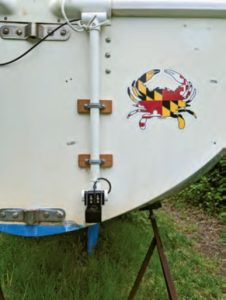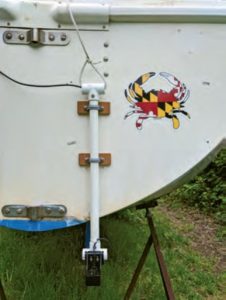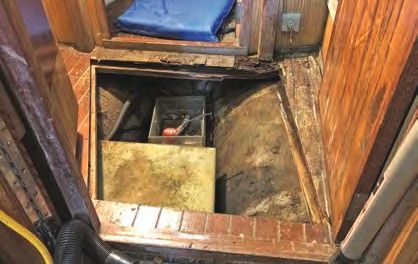A simple elevator system enables top efficiency for depth sounder transducer.
Issue 135: Nov/Dec 2020
If you haven’t run aground, you haven’t sailed the Chesapeake,” is a common refrain among those who ply the thin waters of the largest estuary in the United States. Armed with that nugget of wisdom passed on to me by my sailing friends, one of the first improvements I made to my 1975 Tanzer 26 after buying her in 2011 was to add an inexpensive, transom-mounted depth sounder.

In the up position, the transducer stays well clear of the water while the boat is in the slip, precluding fouling. The critter on the transom is the Maryland flag version of a blue crab, which befits Bradley’s boat, because it bears the scientific name of that iconic crustacean—Callinectes, the beautiful swimmer.
While I still manage to run aground at least once every summer (often while leaving the shallow entrance to my marina on the Nanticoke River), the depth sounder remains one of the most valued pieces of electronic gear aboard my boat. But in the beginning at least, it had some drawbacks.
Since it sat in the water all the time, the depth sounder’s transducer regularly fouled with algae, barnacles, and other gunk, so I had to clean it often. When sailing in choppy water, I found it was unreliable because it tended to go airborne as the stern of the boat rose and fell. I needed a better mousetrap.

Attached to the elevator, the transducer, once in the down position, stays down, no matter how bouncy the sailing gets.
My solution was to build a transducer elevator. Starting with a 2-foot length of ¾-inch PVC pipe, I attached a PVC tee on each end. (I used screws instead of PVC cement, so I could take things apart and make length adjustments and such as I refined my design.) I attached the transducer (with screws) to the lower tee and ran the transducer wire up through the pipe and out the upper tee.
I mounted this assembly to the transom using teak blocks—acting as offsets, they allow the lower pipe tee and transducer to clear the chine—and two-hole plastic conduit straps. I positioned the straps and blocks to permit about 8 inches of vertical movement, plenty for transitioning the transducer from the extremes of well-submerged to high and dry.
The same screws that attach the straps to the blocks also penetrate the transom. The straps are snug enough around the pipe that friction keeps the transducer in the submerged position.
Through the upper pipe tee, I ran a cord that I can use to raise and secure the elevator. The upper pipe tee also makes a convenient handle for sliding the elevator up and down.
I lower the unit when I go sailing and raise it when I’m back at the dock. The transducer stays clean while sitting at the dock, and it stays submerged when we’re under sail. Whether it will help me stay out of the Chesapeake mud? That’s another question entirely!
Brad Stevens is a marine science professor at the University of Maryland Eastern Shore. He first learned to capsize a Sunfish in a farm pond at the age of 11, then moved up to capsizing larger boats. Following a mid-life crisis, he sank a small fortune into refurbishing a Catalina 22 before selling at a complete loss. Not having learned his lesson, he has spent the last 10 years throwing boat bucks into his “almost free” current boat, a 1975 Tanzer 26 #56, which he hasn’t capsized yet.
Thank you to Sailrite Enterprises, Inc., for providing free access to back issues of Good Old Boat through intellectual property rights. Sailrite.com





